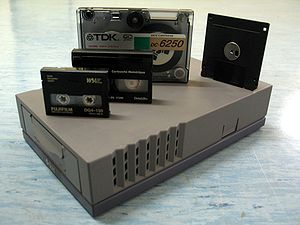Tape drive

A tape drive, also known as a streamer, is a peripheral device that reads and writes data stored on a magnetic tape or a punched tape. It is typically used for archival storage of data stored on hard drives. Tape drives are sequential-access, and must wind past all preceding data to read any one particular piece of data. They are not the fastest form of data storage, as they are sequential, but are long lasting and cost efficient. Modern LTO drives can reach burst transfer rates of over 160 MB/s, with average transfer rates in the 80 MB/s range. Tape drives can be connected with SCSI (most common), parallel port, IDE, USB, FireWire or optical fibre.
Tape drives can range in capacity from a few megabytes to upwards of 800 GB compressed. Tape drive storage is usually referred to with the assumption of 2:1 compression; the raw storage capacity is known as the native capacity.
Tapes and drives come in various formats. These formats include:
- Digital Data Storage (DDS),
- Digital Linear Tape (DLT),
- Linear Tape-Open (LTO),
- Advanced Intelligent Tape (AIT), and
- Quarter Inch Cartridge (QIC), also known as Scalable Linear Recording (SLR)
Tape drives can be found inside autoloaders and tape libraries.
In the 1980s some forms of tape drives were used as inexpensive alternatives to disk drives, examples include the ZX Microdrive and Rotronics Wafadrive.
References
This article is based on material taken from the Free On-line Dictionary of Computing prior to 1 November 2008 and incorporated under the "relicensing" terms of the GFDL, version 1.3 or later.
